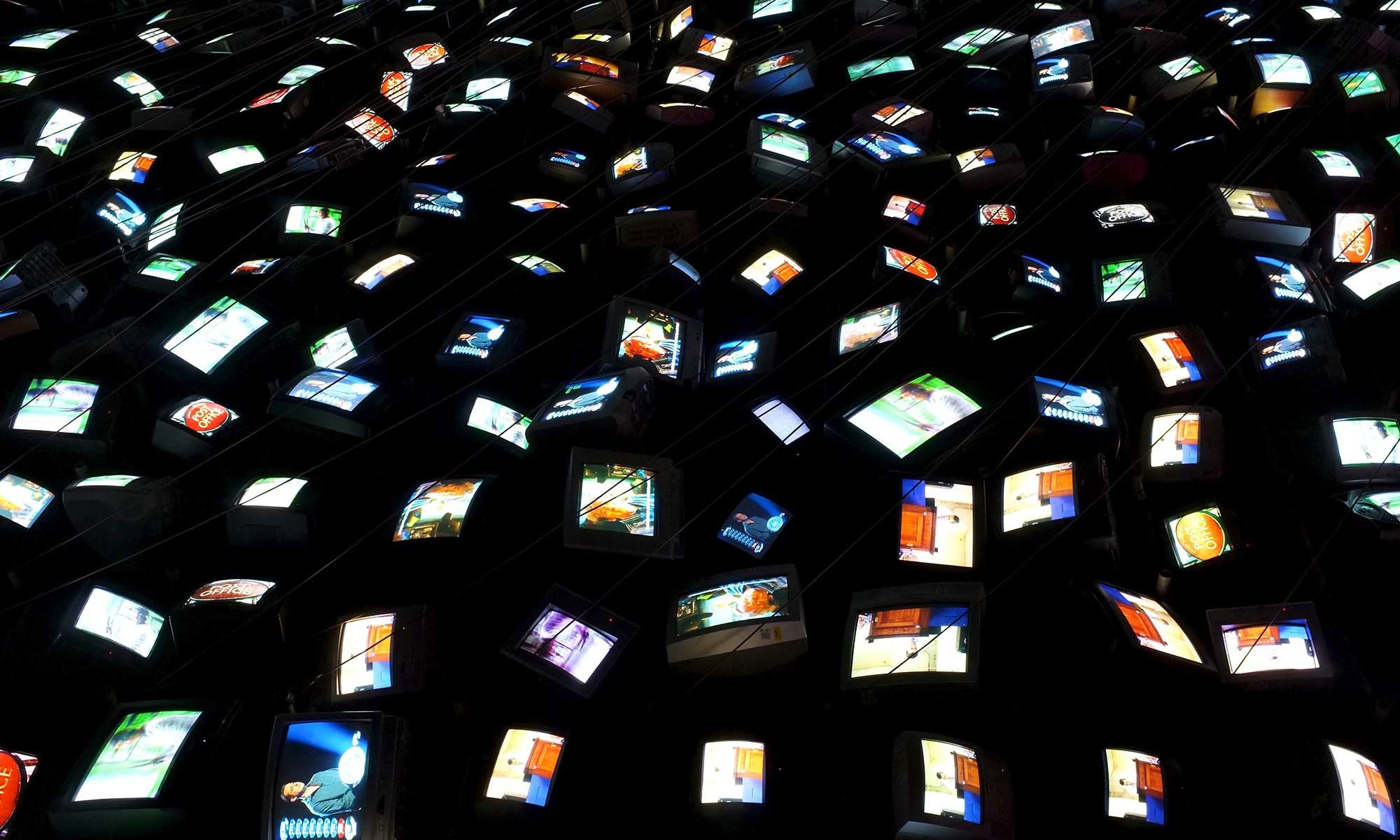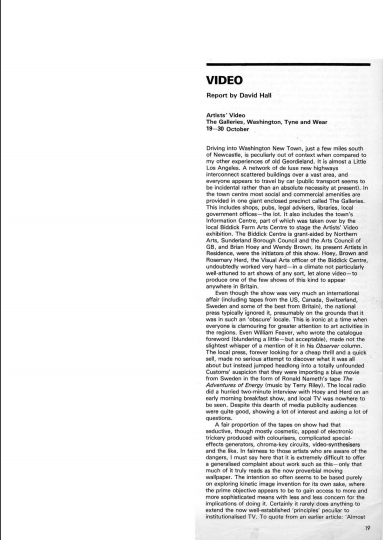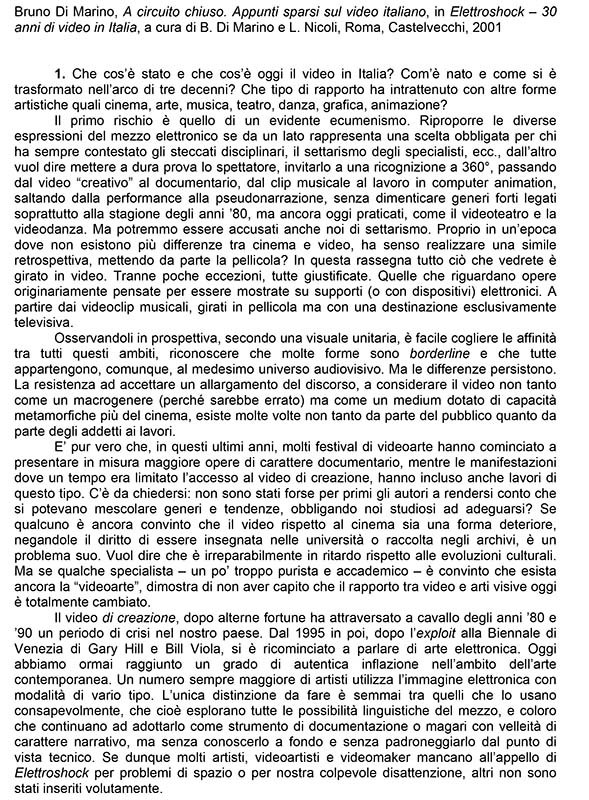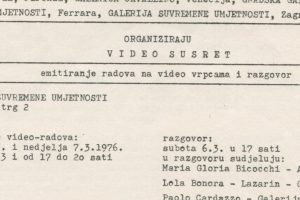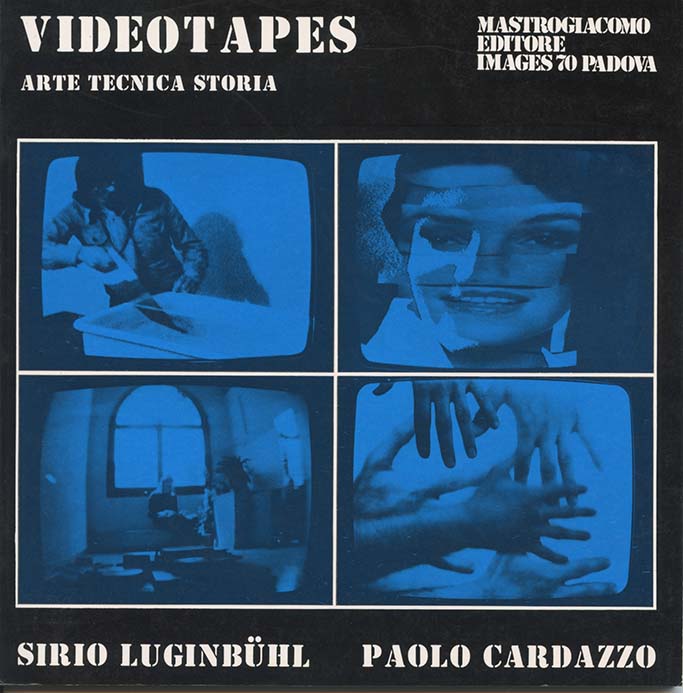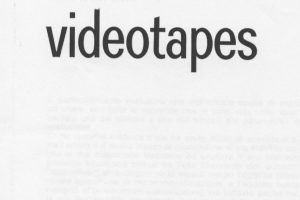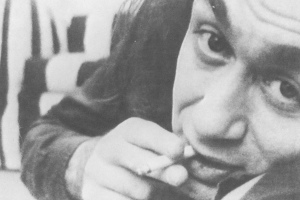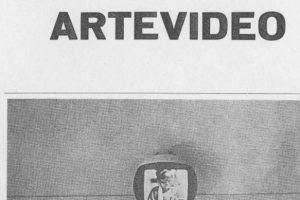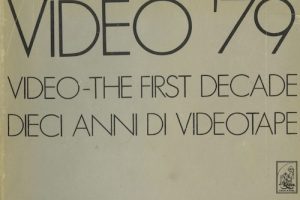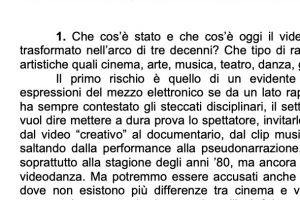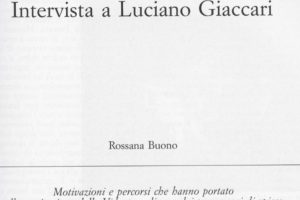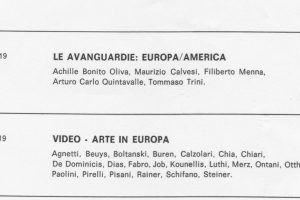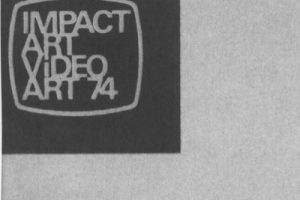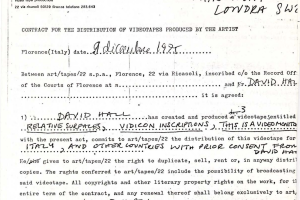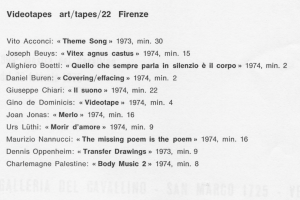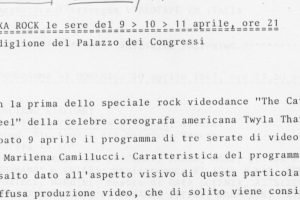Bicocchi, Maria Gloria (Curator, Producer)
Maria Gloria Conti Bicocchi nasce a Firenze dall’artista, pittore, compositore e poeta Primo Conti e Munda Cripps. Sin da bambina cresce a contatto con gli artisti, tra cui De Chirico, Picasso, Papini, Strawinskij, che frequentano la casa del padre.
In seconde nozze sposa l’architetto Giancarlo Bicocchi.
Per breve tempo apre, con due amiche, a Firenze la galleria centrodiffusionegrafica, nata per promuovere multipli e grafiche di artisti italiani e internazionali, che diventa punto d’incontro per artisti, studenti e critici.
Nel 1973 nella casa di via Ricasoli 22 a Firenze, con il sostegno del marito, dà vita ad art/tapes/22 un’iniziativa privata per la produzione di opere artistiche realizzate attraverso l’uso del videotape. Vi partecipano, come tecnici e assistenti, Alberto Pirelli, Carmine Fornari, Lello Carazziari, Ellen Puccinelli e dal 1974 un giovanissimo Bill Viola.
Art/tapes/22 produce in circa tre anni di attività videotape di artisti italiani, europei e statunitensi tra cui Vito Acconci, Alighiero Boetti, Daniel Buren, Pierpaolo Calzolari, Giuseppe Chiari, Douglas Davis, Gino de Dominicis, David Hall, Jannis Kounellis, Ketty La Rocca, Maurizio Nannucci, Giulio Paolini.
I Bicocchi, inoltre, nella casa fiorentina e in quella di Follonica ospitano amici artisti e critici come Germano Celant, Ida Gianelli, Achille Bonito Oliva, Joseph Kosuth, Laura Cherubini, animando un’intesa attività culturale.
Momento fondamentale per la storia di art/tapes/22 è l’incontro nel giugno del 1973 con la gallerista statunitense Ileana Sonnabend alla Kumstmesse di Colonia, dove la Bicocchi presenta i tapes prodotti sino a quel momento da art/tapes/22, invitata nello stand del gallerista napoletano Lucio Amelio. La Bicocchi e la Sonnabend stringono a Parigi un “gentlemen’s agreement”: art/tapes/22 avrebbe potuto lavorare con gli artisti delle gallerie Sonnabend e Castelli (come ad esempio Vito Acconci) per cinque anni al termine dei quali i galleristi americani sarebbero divenuti partner economici dell’impresa. Art/tapes/22, inoltre, diventa distributore ufficiale dei videotapes prodotti da Catelli e Sonnabend in Europa. La prematura chiusura di art/tapes/22 non consentirà l’attuazione della seconda parte dell’accordo.
Nel 1975 una selezione dei tapes sino ad allora prodotti vengono esposti nella mostra itinerante dal titolo “Americans in Florence, Europeans in Florence”, curata dalla Bicocchi insieme al critico americano David Ross, contemporaneamente al Long Beach Museum of Art (California), al Musée d’Art Contemporain di Parigi e al Palais des Beaux Arts di Bruxelles.
Nell’estate del 1976 l’avventura di art/tapes/22 però si interrompe poiché i Bicocchi non riescono più a sostenere le spese per mandare avanti l’iniziativa.
I tapes vengono quindi ceduti a La Biennale di Venezia, alla cui guida vi era all’epoca Carlo Ripa di Meana, Presidente dal 1974 al 79.
In seguito Maria Gloria Bicocchi si trasferisce a Venezia e per breve tempo lavora alla Biennale occupandosi della collezione di videotapes presso l’ASAC archivio Storico delle Arti Contemporanee, organizzando varie attività, tra cui il seminario “Artisti e videotape” (1-16 ottobre 1977), il corso “Teoria e tecnica del videotape” (26 ottobre-5 novembre 1977) e la rassegna “Gli art/tapes dell’ASAC” (7-12 novembre 1977). Nell’ambito del seminario, vengono invitati tra gli altri Marshall McLuhan per la prima volta in Italia, e il sociologo Franco Ferrarotti.
La collaborazione della Biocchi con la Biennale termina di lì a poco.
Nel 2003 la Bicocchi ha pubblicato con le Edizioni del Cavallino di Paolo Cardazzo il volume “Tra Firenze e Santa Teresa dentro le quinte dell’arte (’73/’87). Art/tapes/22”.
Attualmente Maria Gloria Bicocchi vive a Procida.
Maria Gloria Conti Bicocchi was born in Florence. She is the daughter of artist, painter, composer and poet Primo Conti and Munda Cripps. Since her childhood she was in contact with artists, including, De Chirico, Picasso, Papini and Strawinskij, who hung out at her father’s house. She married the architect Giancarlo Bicocchi.
Briefly, with two friends, she opened a gallery in Florence called centrodiffusionegrafia, to promote visual art by Italian and International artists. It became a meeting place for artists, students and critics.
In 1973 at her apartment in via Ricasoli 22 in Florence, with the support of her husband, she created art/tapes/22. This was a private initiative for the production of artists’ videotapes. Alberto Pirelli, Carmine Fornari, Lello Carazziari, Ellen Puccinelli worked there as technicians and assistants and from 1974 a very young Bill Viola. In the three years of activity at art/tapes/22 they produced videotapes by Italian, European and American artists such as Vito Acconci, Alighiero Boetti, Daniel Buren, Pierpaolo Calzolari, Giuseppe Chiari, Douglas Davis, Gino de Dominicis, David Hall, Jannis Kounellis, Ketty La Rocca, Maurizio Nannucci and Giulio Paolini
Also, the Bicocchis, in their homes in Florence and Follonica they hosted friends who were artists and critics such as Germano Celant, Ida Gianelli, Achille Bonito Oliva, Joseph Kosuth, Laura Cherubini which created lively cultural activity. A fundamental moment for the history of art/tapes/22 was, in June 1973 when Bicocchi met the American gallerist Ileana Sonnabend at Koln Kunstmesse. She was presenting videotapes produced previously by art/tapes/22 where she was invited by the Neapolitan gallerist, Lucio Amelio. Bicocchi and Sonnabend made a ‘gentlemen’s agreement’ that art/tapes/22 would work with artists from Sonnabend and Catselli galleries (such as Vito Acconci) for five years, then, at the end of which the two American gallerists would become partners of the initiative. Art/tapes/22 also became the official distributor of Castelli and Sonnabend galleries’ videotape productions in Europe. Unfortunately, the second part of the agreement was never realised because of art/tapes/22’s premature closure.
In 1975 a selection of video works, produced since then, were shown at an exhibit entitled ‘Americans in Florence. Europeans in Florence’, curated by Maria Gloria Bicocchi and the American critic David Ross. It opened simultaneously at the Long Beach Museum of Art (California), at the Musée d’Art Contemporain in Paris and at the Palais des Beaux Arts in Brussels. In the summer of 1976, the art/tapes/22’s venture came to an end because the Bicocchis couldn’t afford to keep the initiative going. The tapes were then ceded to the Venice Biennale, which at the time was directed by Carlo Ripa di Meana, who was President from 1974 to 1979. Later, Maria Gloria Bicocchi moved to Venice and for a brief time worked at the Biennale with the videotape collection, which was deposited at ASAC the Archive of Contemporary Arts, organising various activities, e.g. the seminar “Artisti e videotape” (Artists and videotape, 1st-16th October 1977), the course “Teoria e tecnica del videotape” (Theory and technique of the videotape, 26th October-5th November 1977) and the screening “Gli art/tapes dell’ASAC (ASAC’s art/tapes, 7th-12th November 1977). At the seminar, among the invited speakers, were Marshall McLuhan, his first time in Italy, and the sociologist Franco Ferrarotti. Bicocchi’s collaboration with the Venice Biennale ended soon after that.
In 2003, Bicocchi published the book “Tra Firenze e Santa Teresa dentro le quinte dell’arte (’73/’87). Art/tapes/22” for Paolo Cardazzo’s Edizioni del Cavallino.
Maria Gloria Bicocchi currently lives in Procida.
updated April 2022
-
Interview of Maria Gloria Biccochi by Stephen Partridge and Laura Leuzzi
-
Exhibitions:
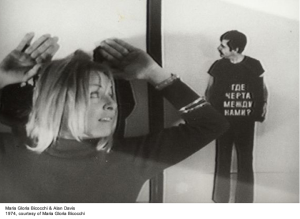
MGB 1974 
MGB with Bill Viola 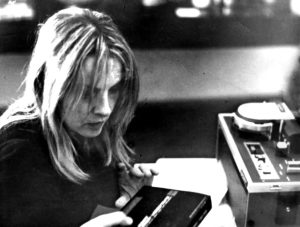
MGB with Sony VTR at art/tapes/22 1974 -
Videography:
A selection of video works produced by art/tapes/22
Vito Acconci
Come Back, 1973, b/w, 33m 24s, sound
Full Circle, 1973, b/w, 32m 43s, sound
Home Movies, 1973, b/w, 33m 24s, sound
Indirect Approches, 1973, b/w, 33m 11s, sound
Theme Song, 1973, b/w, 33m 19s, soundVincenzo Agnetti
Documentario N?2, 1973, b/w, 8m, soundEnrico Bafico
Corrispondenze n. 1, 1975, b/w, 11m 29s, sound
Corrispondenze n. 2, 1975, b/w, 13m 38s, soundJohn Baldessarri
The Italian Tape, 1974, b/w, 8m 32s, sound, produced by the artist for art/tapes/22 in New York, in collaboration with Sonnabend Video Films CorporationAlighiero Boetti
CiÚ che sempre parla in silenzio Ë il corpo, 1974, b/w, 1m, muteChristian Boltanski
La vie est triste, la vie est gaie, 1974, b/w, 25m, sound
Quelque souvenir de jeunesse, 1974, b/w, 14m 45s, soundChris Burden
Afternoon at Portarossa Hotel, 1975, b/w, 14m 48s, sound
Car Nut, 1975, b/w, 27m, sound
Guru for Detroit, 1975, b/w, 14m 48s, sound
Italian Interview by Alexis Smith, part I, 1975, b/w, 46m 05s, sound
Italian Interview by Alexis Smith, part II, 1975, b/w, 30m, soundDaniel Buren
VidÈo-Souvenir, (Recouvrant-EffaÁant 3), 1974, b/w, 2m, soundPierpaolo Calzolari
No title 1, 1974, b/w, 10m 33s, sound
No title 2, 1974, b/w, 6m, soundSandro Chia
Di come il fuoco rigenera la candela, 1975, b/w, 23m 54s, mute
Tempo medio per un videotape, 1975, b/w, 7m 17s, mute
The Nave-Less Singe, 1975, b/w, 8m, muteAndrea Daninos
Show of Everybodyís Death, 1974, b/w, 7m 05s, soundGino De Dominicis
Videotape, 1974, b/n, 2m 09s, soundMarco Del Re
One small step for man, one giant leap for mankind, 1974, b/w, 11m 29s, sound
Come Sbarcare il Lunario, 1975, b/w, 15m, sound
Safari Horror, 1975, b/w, 17s 28m, sound
Safari Means Trip, 1975, b/w, 14m, sound
Souvenir di Firenze parte I ñ Tema di Piazza Vittoria, 1975, b/w, 28m 57s, sound
Souvenir di Firenze parte II ñ Tema di Piazza Vittoria, 1975, b/w, 30m, sound
Theme for a Race of Survival, 1975, b/w, 15m 14s, sound
Una Sadica Indiscrezione, 1975, b/w, 15m 14s, soundAndrea Granchi
I militari, 1975, b/w, 2m 33s, soundFrank Gillette
Three Tuscan Fields and the Birds of Madagascar, 1974, b/w, 30m, soundRebecca Horn
Videotape n. 3, 1973, b/w, 29m 46s, soundTaka Ito Iimura
Field Work, 1974, b/w, 25m, sound
Self Identity, 1974, b/w, 20m 58s, soundJoan Jonas
Merlo, 1974, b/w, 10m 53s, soundAllan Kaprow
Then, 1974, b/w, 23m 38s, sound, in collaboration with Galleria Multipla, Milan
Third Routine, 1974, b/w, 59m 49s, soundJannis Kounellis
No title, 1973, b/w, 25m, soundLes Levines
Les Levineís Firenze, 1974, b/w, 29m 20s, soundUrs L¸thi
Interview I, 1974, b/w, 25m 57s, sound, in collaboration with Galleria Schema, Florence
Morire díAmore, 1974, b/w, 8m 49s, sound
Self Portrait, 1974, b/w, 8m 07s, soundGerald Minkoff
Frivolezza, 1975, b/w, 10m 34s, sound
The Sixtina Misunderstanding, 1975, b/w, 5m 39s, sound
This is not a piano piece (also known as This is a piano piece), 1975, b/w, 23m 30s, mute
Video Blind: First Touch, Second Touch, Third Touch, 1975, b/w, 19s 11m, soundMaurizio Nannucci
The Missing Poemi s the Poem, 1974, b/w, 15m 54s, soundMuriel Olesen
Jim, Jill and Jane, John, 1975, b/w, 15m, sound
No title, 1975, b/w, 15m, sound, produced by the artist for art/tapes/22 in New York, in collaboration with Sonnabend Video Films CorporationLuciano Ori
Poesia visiva, 1974, b/w, 16m 17s, soundJean Otth
Limite B (Le Lac), 1973, b/w, 12s 34m, sound
Limite E (Le Lac), 1973, b/w, 10s 56m, sound
Portrait de Laura Papi, 1975, b/w, 12s 05m, soundCharlemagne Palestine
Body Music 1, 1974, b/w, 5m sound, in collaboration with Sonnabend Video Films Corporation
Body Music 2, 1974, b/w, 8m 03s, soundGiulio Paolini
Unisono, 1974, b/w, 1m 03s, soundClaudio Parmiggiani
Delocazione, 1974, b/w, 8m 13s, soundAlberto Pirelli
Riconoscere, il riconoscimento, 1974, b/w, 23m 57s, sound
Stay Tuned, 1974, b/w, 20m, soundLucio Pozzi
A Boetti Suggestion, 1975, b/w, 42m, mute
Portrait of Maria Gloria, 1975, b/w, 1m 09s, mute
Two times, 1975, b/w, 5m 10s, mute
Updownleftright (left monitor, right monitor), 1975, b/w, 10m 40s, muteAdulf Rainer
Confrontation with my videoimage, 1974, b/w, 35m 39s, sound
Mouth Piece, 1974, b/w, 6s 35m, sound
Slow Motion, 1974, b/w, 9s 53m, soundWilloughby Sharp
Break, 1973, b/w, monitor 1 19í 44î, monitor 2m 30s, soundBill Viola
Eclipse, 1974, b/w, 18í 55î, sound
Gravitation Pull / Gravitational Pull, 1974, b/w, 10m, sound -
Artist organisations:
-
Artist assets:
